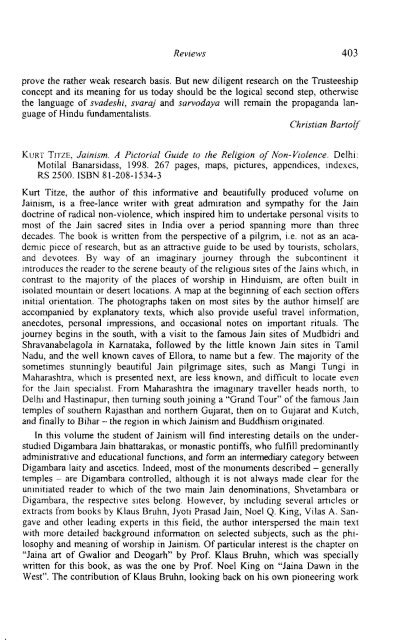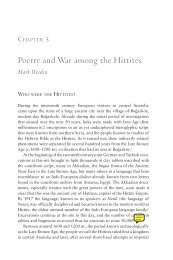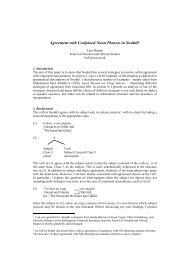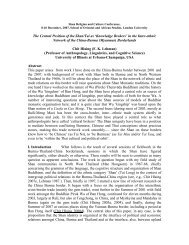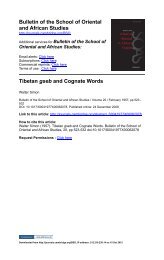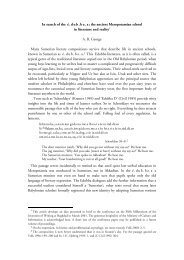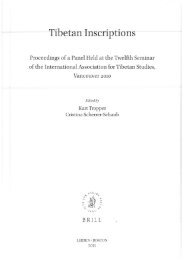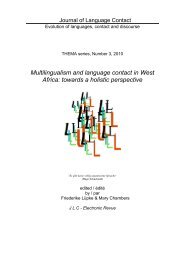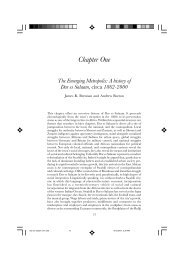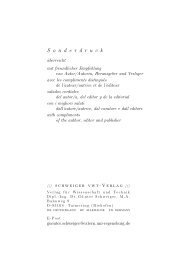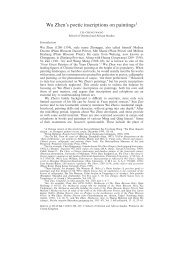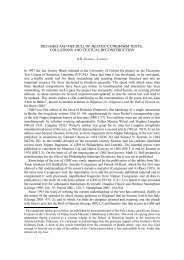You also want an ePaper? Increase the reach of your titles
YUMPU automatically turns print PDFs into web optimized ePapers that Google loves.
<strong>Review</strong>s 403<br />
prove the rather weak research basis. But new dirigent research on the Trusteeship<br />
rts meaning for us roday should<br />
:::::lTl9<br />
be th-e togical ,..ona it.p. oit"*ir.<br />
rne ranguage or svadeshi, sllaraj and sarvodaya wilr remain the propaganda language<br />
of Hindu fundamentalists.<br />
Christian Bartolf<br />
Kunr TrrzE, Jainism. A pictoriar Guide to the Rerigion of Non-viorence. Derhi:<br />
Y:!t:]^eTgsidass,^^l 99€. pages,<br />
].67<br />
maps, prctures, appendices, indexes,<br />
RS 2500. rsBN 8l_208_1534_3<br />
Kurt Titze, the author of this informative and beautifully produced volume on<br />
Jainism, is a free-lance writer with great admiration una'sy-paitrl-ror lrre lai'<br />
doctrine ofradical non-violence, whicl inspired him to undertak" p.isonat uirit, to<br />
most of the Jain sacred. sites^ in India over a period spanning ,noi. tr,un tr,r".<br />
decades The book is written from the perspective of a pirgrim,"i... not u. un u.u-<br />
demic. piece of research, but as an utt u.tiu. guide to be used by tourists, scholars,<br />
and devotees. By way of an imaginary j"oumey through tlre subcontinent it<br />
rntroduces the reader to the-serene beauty ofthe religious siies ofthe Jains rvhrch, in<br />
contrast to the ma.;oriry of the places of worship in Hinduism, ur. oit.r, fuilt in<br />
rsorarecl mountarn or desert locations. A map at the beginning of each section offers<br />
rnitial orientation. The photographs taken on most sites by-the author himself are<br />
accompanied by explanatory texts, which also provide uieful travel informatron,<br />
personal impressions,<br />
llll9"!"il<br />
and occasionai nores on rmportant rituals. The<br />
Journey begrns rn the south, with a visit to the famous Jain sites of Mudbidri and<br />
strravanabelagola in Kamataka, foilowed by the rittre known Jain sites in Tamil<br />
Nadu, and the well known caves of Ellora, to nu,n. but a few. rr,. ."1"riif or tn.<br />
sometrmes stunningly beautiful Jain pirgrimage sites, such as vangi rungi in<br />
Maharashtra, which is presented next, are-lessino*n, and difficult to locate even<br />
for..the Jain specialist. From Maharashtra the imagrnary traveller heads north, to<br />
Delhi and ]Iastinapur, then turning south joining a ,icrand Tour,' of the famous Jarn<br />
:.-Tpl::,?-f :"*hem R.ajasthan and northirn cu]arat, then on to Culurut unJf ut.f.,,<br />
ano .na,y ro Blhar - the region in which Jainism and Buddhism originated.<br />
In this volume the student of Jainism will find interesting details on the understudied<br />
Digambara Jain bhattarakas,.or monastic pontiffs, wh"o rutntt pr"ao,ninuntry<br />
administrative and educationar functions, and form an intermediary.ut!go.y u.*.rn<br />
Digambara laity and ascetics. Indeed, most of the monuments aeicribei-lenerally<br />
temples -.are Digambara controlled, although it is not always made cleai for the<br />
uninitiated reader to which of the two maii Jain denominations, Shvetamba.u<br />
Digambara'<br />
or<br />
the respectrve sites belong. However, by incruding several articres<br />
extracts<br />
or<br />
from books by Klaus Bruhn, Jyoti prasad Jain, Noel e.i(ing, vir^, e. s""g1:,..r.td<br />
other leading.experts in this field, the author interipersei the _uin t.*t<br />
background information<br />
I,:f::_,d:l-"lled<br />
on selected subjects, such as the phi_<br />
r.o-sopny and-meanlng of worship in Jainism. of particular inierest is the chapter<br />
"Jaina<br />
on<br />
art of Gwalior and Deogarh" by prof. Kraus Bruhn, which was ,f..iutty<br />
writtenfor this book, as yr thi one by prof. ttoer ring on "Jaina ouuni in tt.<br />
west". The contribution of Klaus Bruhn, looking back oniis o*" pi"*..irg'*"rt
404 <strong>Review</strong>s<br />
in Deogarh some forty years ago, illuminates the chronology and regional style of<br />
Jaina art in Gwalior and Deogarh in central India 700-1250 AD. It also points to the<br />
necessity ofreconstructing local history from the "scattered epigraphical evidence',,<br />
and calls "for an intensified evaluation of the available material and for the<br />
collection ofnew data" (103). In his description ofthe Tirthankara images at these<br />
sites, Bruhn emphasizes that "Jinas are normally shown stark naked. Jinas weanns a<br />
dhoti are only found in rhe shvetambara art of cujarat and southern Rajasrhin"<br />
(106). Bruhn describes the "miracle motifs" associated with them, that is "emblems<br />
of royalty which surround the Jina in a singular manner" (107), which do not strictly<br />
belong to soteriological Jainism. Though emphasizing that "Deogarh is still what it<br />
was" (l16), he illustrates the damage caused both by art robbers and attempts of<br />
preservation by juxtaposing recent pictures with a photograph reproduced from the<br />
Archaeological Survey of India ( I 9l 8), which depicts the Jaina temples of Deogarh<br />
before their reconstruction for purposes of religious tourism (li5). Kurt Titze<br />
himself establishes a similar contrast in his section on the restored Tirthankara<br />
image at Chulagiri, reconsecrated in l99l ( 130f.).<br />
The pictures in this book indicate that the recent efforts of the Jain community<br />
do not only concentrate on the restoration ofold sites but also on the construction of<br />
entircly new buildings, which are the main indications of the contemporary Jain<br />
renaissance in India. At present, they are being erected in large numbers ind at great<br />
speed, often at historic Jain locations which were later abandoned, such as the<br />
Jambu-dvipa monument at Hastinapur (139), the Mahavira Mandir at pavapuri<br />
(207), the new structures in Rajgir (205), Ajmer's Nasiayan remple (143), or the<br />
new Samavasarana temple at the foot of Satrunjay hill (232). Their architecture,<br />
generally depicting Jain cosmological themes, is very innovative. It strikes the<br />
reader who compares the pictures of old and new temples in this book that the new<br />
communal self-assertiveness of the Jains manifests itself in these modern buildings,<br />
sometimes made of concrete, which boldly embody Jain imagery in their structural<br />
design; in stark contrast to medieval Jain temples. which. as professor Bruhn<br />
explains, "had a'neutral'exterior contrary to Hindu temples, where figures on rhe<br />
outer walls leave no doubt as to the l{indu character of the building" ("this was the<br />
price to be paid for the easily granted permission to erect Jaina temples under Hindu<br />
rulers") (l I l).<br />
The volume also contains indexes and useful appendices for the general reader<br />
on the distribution of the Jaina population in India, a bibliography, a glossary,<br />
addresses, and a list of Jain periodicals. on his journeys the author -it -uny<br />
prominent Jain monks and nuns from the whole spectrum of Jain traditions. The<br />
short descriptions of the encounters with these mendicants, some of whom were<br />
photographed (which, as the author emphasizes, was not permitted by orthodox<br />
ascetics), are the most vividly narrated parts of the volume, only matched by the<br />
chapter on "charitable and social traditions in Jainism" (zl3-zz0), which celebrates<br />
the utopian spirit behind the modem Jain religious schools, the gurukuls and<br />
dharmasthalas, women's ashrams, and Jain eye hospitals, that were inaugurated by<br />
the sympathizers of the world Jain Mission. It is only here that we get a glimpse of<br />
contemporary Jain ways of life. The majority of the photographs in this pioorial<br />
guide to Jainism show Digambara Jain temples and their interior in isolated
<strong>Review</strong>s 405<br />
mountain sites, which were originally sanctified by the practice of sallekhana, or<br />
religious death through self-starvation. The attractive, mostly black and white<br />
pictures allow a comprehensive and unique glimpse into the iichness of the Jarn<br />
heritage, which was not hitherto available in this form.<br />
peter Fliisel<br />
Krnus-Joser No11 Qrrsg ), Das Lexikon des Buddhisnurs. Grundbegrife, Traditonen,<br />
Prarri. Band I, II. Freiburg/Basel/wien: Herder, tsss. orz*s6iten, DM 6g,-.<br />
rsBN 3-451-04700-4<br />
Ein solides und zuverliissiges Nachschlagewerk tiber den Buddhismus ist besonders<br />
bei der wachsenden verbreitung dieser Religion auch in westlichen Liindem ein dringendes<br />
Desiderat. Die gro8en und in absehbarer zeit nicht abzuschlie8enden werke<br />
wie der vorztigliche H6b6girin oder die unzuliingliche Encyclopaedia of Bttdtlhism<br />
kcinnen dieses Bediirfnis nicht befriedigen und wenden sic-h auBerdem zuniichst an<br />
den Fachgelehrten. Nyanatilokas nt.itzliches Buddhistisches Worterbuch beschriinkt<br />
sich auf die Theravada-Terminologie. Das nun vorgelegte werk fiillt.ledoch die oft<br />
empfundene Liicke in hervonagender weise. UmsiJhtig ausgewiihlte, i


